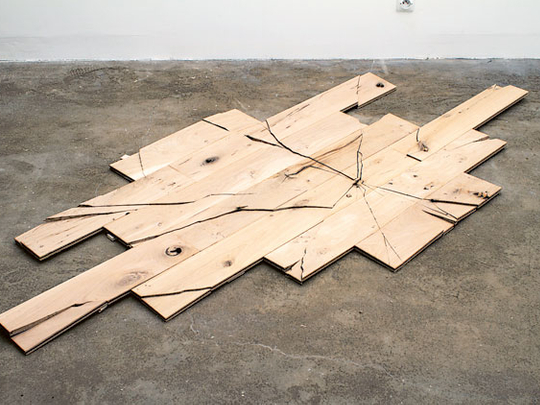
Our perception of reality is the central theme of Abdelkader Benchamma’s work. The French-Algerian artist uses a simple black felt pen on white paper to create complex, layered drawings that reflect the multiple realities around us.
His previous work featured human figures in strange surrealistic situations. But the drawings in his latest series, titled Corrupted Theories, are a curious blend of form and abstraction, real and imaginary, solid and fluid, stillness and movement.
The amorphous shapes in these drawings convey a sense of the ambiguities and instability that are part of our existence and question the concept of a single, stable reality.
“I like to use simple techniques and the simple medium of drawing. But I am constantly looking for new ways to express myself and engage my viewers. The artworks in this series look like precise scientific drawings. But, I have actually corrupted the accepted theories regarding the nature of matter to create a different reality and to provoke viewers to think about their perceptions of reality as well as the very concept of reality itself,” the artist says.
Benchamma takes inspiration from various sources such as science fiction, cosmology, existentialist theatre and contemporary literature to construct his layered narratives. He has explored the idea of intuitive perception through a drawing of what looks like a galaxy, built from tiny pieces of wood and held together with strings.
“It is interesting that philosophers and writers have spoken and written about concepts such as vast galaxies and miniscule atoms long before astronomers and scientists proved their existence. I have tried to depict how those people might have visualized the galaxy at that time. The pieces of wood and string are basic materials that symbolise the very rudimentary knowledge available to them. The drawing speaks about our perception of something that is invisible and incomprehensible and the possibility of imagining reality,” Benchamma says.
In another drawing titled, ‘Landscape without light’, the artist has juxtaposed reality with the illusion of reality created in a theatre. What you see is a panorama of tree covered mountains done in shades of gray, blue, brown and black. But a closer look reveals that many of the mountains and trees are mere facades.
Besides these theatrical backdrops arranged in the midst of real trees and mountain slopes, other props such as sculptures have also been incorporated in the landscape. The drawing makes you wonder what is real and what is fake in the world around you; and it makes you question who created the fake things and why.
“The different layers in this drawing reflect the many different realities that exist in this world. And the mingling of real and fake objects provokes questions about reality and artifice. Even the many colours that you see are about perception, because I have only used many different black pens to create all these shades,” the artist says.
Benchamma’s most recent series of drawings, titled Sculpture, investigate different dimensions of reality. They feature strange structures that appear to be carefully constructed from blocks of wood, grills, scaffolding, tarpaulin and fences. But the way these things are stacked is inherently unstable.
As the eye moves upwards, the solid materials dematerialize into fluid lines that look like clouds, swirling water or explosions and represent the artist’s visualisation of the invisible energy that flows inside and around us. The energy moves through fake landscapes and multiple channels, but in several places the artist has restrained the flow with ropes, belts and nails.
Thus the drawings are a combination of real objects, visualization of an invisible reality, suggestion of multiple realities and the imagination of seemingly impossible realities. The fact that despite the lines being precise, the image formed is elusive questions the idea of one stable reality in the chaotic environment around us.
“I have tried to achieve a three dimensional sculptural quality in these drawings to create a sense of mystery about what is behind or inside these structures. The amorphous forms depict the conflict between matter, movement and restriction. The construction materials are a metaphor for the way we construct our reality with our feelings, thoughts, experiences, consciousness and perception of real and fake; and the fluid lines imply the constant changes in these building blocks. I particularly like to use wooden blocks in my drawings because wood is a good example of the ambiguous nature of reality and different perceptions of it. From the outside it appears like a hard, solid object. But from the perspective of a termite or woodworm, it is something soft that they can burrow through. I want to take viewers deep inside the matter and also offer a different perspective from a distance,” the artist says.
Benchamma is also exhibiting two interesting sculptures featuring planks of wood that seem to have shattered like glass. “Creating this illusion of wood being as fragile as glass is a more tangible way of questioning our concept of reality,” he says.
Jyoti Kalsi is an arts enthusiast based in Dubai
Corrupted Theories will run at gallery Isabelle Van Den Eynde until July 15.













